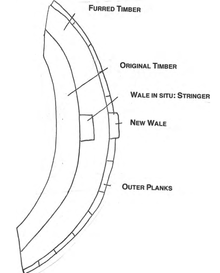Furring
In construction, furring (furring strips) are thin strips of wood or other material to level or raise surfaces of another material to prevent dampness, to make space for insulation, or to level and resurface ceilings or walls.[1] Furring refers to the process of installing the strips and to the strips themselves. "Firring" is a U.K. term for wood strips which are usually 50 mm wide, tapered and fixed above wood roof joists to provide drainage falls below roof boarding. Furring strips themselves are typically referred to as "battens" in the U.K. and sometimes the material is called "strapping" in the U.S.
In buildings
Wood furring strips typically measure 1" x 2" or 1" x 3". They can be laid out perpendicular to studs or joists and nailed to them, or set vertically against an existing wall surface. The spacing between the strips depends on the type of finishing material. Wider spacing is typically used behind the heavy boards that support ceramic tiles. Closely spaced strips are needed for thin panelling or plaster. The use of strips with plaster, however, is called either lath and plaster or wattle and daub.
Metal furring strips can be used for commercial projects, or in towns where fire-proof supporting elements are required by the local building code. Often called "hat channels" to describe the profile (cross section), they consist of two flanges on each side of a trapezoid shape, 7/8" thick.
Furring is also used to support roof materials and may be seen under barn and shed roofs, but is often replaced in contemporary times by labor-saving plywood. Drywall has become the most common interior wall finishing material and does not need furring due to its strength. Furring is still used in remodeling work to fill out uneven sections for resurfacing, or to add room for insulation.
Ship repair

Furring, is a type of ship rebuilding method indicative of the late 16th century and early 17th century England. It was adopted as a remedial process to solve crank ships that were built too narrow. When a ship could not bear sail or was too narrow or her bearing laid too low, a second layer of frames were attached to the first to make her broader and lay her bearing higher. This was done by ripping the planks off and applying the second frames on top of the original frames, and then adding the planks back on. "They commonly fur some two or three strakes under water and as much above, according as the ship requires, more or less." (Mainwaring, 153)
Although this appeared to have fixed the problems with "makeshift corrections" due to miscalculation, it was seen as a poor remedy and at times was used as a black listing method among shipwrights during the end of the 16th century and beginning of the 17th century England (ex. Phineas Pett and the Prince Royal).
Because it was seen as such an incompetent occurrence to miscalculate while building, even the writers of the time had plenty to say about its uncertainties: "I think in all the world there are not so many ships furred as are in England, and it is a pity that there is no order taken either for the punishing of those who build such ships or the preventing of it, for it is an infinite loss to the owners and an utter spoiling and disgrace to all ships that are so handled (Mainwaring, 153)".
The only archaeological evidence of furring found to date, is the Princes Channel Wreck, excavated and recovered by Wessex Archaeology. There has been debate as to the preliminary naming of the wreck, as it was found in the Princes Channel at the mouth of the Thames estuary. However the more popular name of Gresham Ship was introduced when the guns on board the vessel revealed a grasshopper insignia, which was the motif made by Sir Thomas Gresham, founder of the Royal Exchange.
See also
References
- ↑ "furring" def. 2.b and 2.c. Oxford English Dictionary Second Edition on CD-ROM (v. 4.0) © Oxford University Press 2009
- Mainwaring, G. E. & Perrin, W. G. (Ed.) (1922). The Life and works of Sir Henry Mainwaring. Volume II: The Seaman’s Dictionary. Navy Records Society: London.
- Wagstaffe, Cate. 2010. Furring in the light of 16th century ship design. MA thesis, SDU: Esbjerg.
- furring diagram